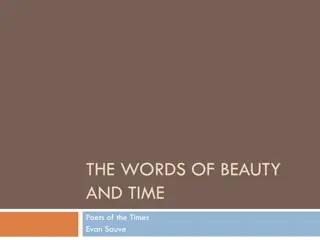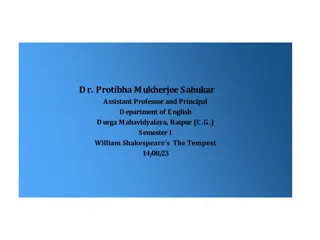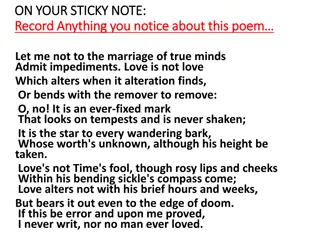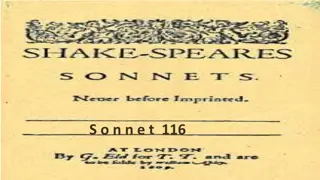Analysis of Sonnet 18 by William Shakespeare
The famous Sonnet 18 by William Shakespeare praises the eternal beauty of the beloved. The poet compares the beloved to a summer day but highlights the beloved's superiority due to their enduring beauty. The sonnet explores themes of timelessness, love, and the power of poetry to immortalize beauty. It stands out in Shakespeare's sonnets for its admiration of the beloved's everlasting beauty without focusing on procreation.
Uploaded on Sep 21, 2024 | 1 Views
Download Presentation

Please find below an Image/Link to download the presentation.
The content on the website is provided AS IS for your information and personal use only. It may not be sold, licensed, or shared on other websites without obtaining consent from the author.If you encounter any issues during the download, it is possible that the publisher has removed the file from their server.
You are allowed to download the files provided on this website for personal or commercial use, subject to the condition that they are used lawfully. All files are the property of their respective owners.
The content on the website is provided AS IS for your information and personal use only. It may not be sold, licensed, or shared on other websites without obtaining consent from the author.
E N D
Presentation Transcript
Sonnet 18 by William Shakespeare
Structure The sonnet consists of 3 quatrains rhyming ababcd cd ef ef and a couplet (epigrammatic) Rhyming gg. The images the poet used are mainly taken from nature.
Summary The speaker opens the poem with a rhetorical question addressed to the beloved friend , the fair lord , : Shall I compare thee to a summer s day . The next eleven lines are devoted to such a comparison ( metaphor ). In line 2 , the speaker stipulates what makes his friend different from a summer s day : he is more lovely and more temperate . Summer s days tend toward extremes : they are shaken by rough winds ; in them , the sun ( the eye of heaven ) often shines too hot , or too dim . And summer is fleeting : its date is too short , and it leads to the withering of autumn, as every fair from fair sometime declines .
To be continued The final quatrain of the sonnet tells how the beloved differs from the summer in that respect : his beauty will last forever ( Thy eternal summer shall not fade ) and never die . In the couplet , the speaker explains how the beloved s beauty will not perish because it is preserved in the poem , which will last forever ; it will live as long as men can breathe or eyes can see
Commentary This sonnet is certainly the most famous in the sequence of Shakespeare s sonnets ; it may be the most famous lyric poem in English . On the surface , the poem is simply a statement of praise about the beauty of the beloved ; summer tends to unpleasant extremes of windiness and heat , but the beloved is always mild and temperate . Summer is personified as the eye of heaven with its gold complexion ; the imagery throughout is simple and unaffected , with the darling buds of May giving way to the eternal summer , which the speaker promises the beloved.
Commentary Sonnet 18 is the first poem in the sonnets not to explicitly encourage the young man to have children . The procreation sequence of the first 17 sonnets ended with the poet s realization that the young man might not need children to preserve his beauty ; he could also live , the poet writes at the end of sonnet 17 , in my rhyme .
To be continued Sonnet 18 , then , is the first rhyme --- the poet s first attempt to preserve the young man s beauty for all time . Another important theme of the sonnet is the power of the speaker s poem to defy time and last forever , carrying the beauty of the beloved down to future generations . The beloved s eternal summer shall not fade because it is embodied in the sonnet : so long as men can breathe or eyes can see , the speaker writes in the couplet , so long lives this and this gives life to thee .
Devices 1. Rhetorical question : a question tended to provoke thought , but not an expressed answer , in the reader. 2. Metaphor 3. Personification 3. Pun : a play on words that have similar sounds but different meanings, every faire from faire sometimes declines . The first faire means beautiful and the second one means beauty.






















